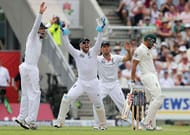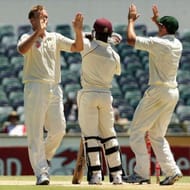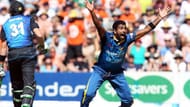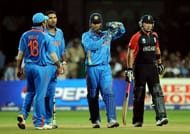To use DRS or not to use DRS that is the question. This debate is no less than a Shakespearean drama that still continues to unfold in the minds of the cricket connoisseurs across the globe. UDRS or DRS was first introduced on November 24, 2009, when Pakistan and New Zealand squared off against each other in the first test at Dunedin. It was used for the first time in ODIs during England's tour of Australia in January 2011 and later used in the 2011 World Cup as well.
Also Read: Video: Yasir Shah brings back memories of Shane Warne's magical delivery
The idea was to eradicate errors coming from the on-field umpires and basically make the game more fair by the use technology. The batsman/bowler could challenge a decision of an on-field umpire and the third umpire’s help is sought. The third umpire tries to come to a conclusion by using technology based tools like the Hawk-Eye, the Hot-Spot, and the Snickometer to make the correct decision.
Also Read: 5 batsmen who scored a double century and a duck in the same Test
The reception so far has been rather mixed and some of the following instances bear testimony to the fact that DRS may not be 100% foolproof.
1. Nathan Lyon: Australia v New Zealand, 2nd Test, 2015, Adelaide
This was the most controversial decision of recent times when DRS came a cropper at a crucial stage in the first ever day-night test at Adelaide. Now to the ball in question; left arm spinner Mitchell Santner came round the wicket and Lyon went for an ambitious sweep shot. The ball clearly hit the top edge of his blade going on to his shoulder and popping up to gully. Umpire S Ravi adjudged it not out but the Kiwis took a review.
The replays showed the ball kissing Lyon's bat but Nigel Llong, the third umpire deemed the evidence inconclusive and the decision of the on-field umpire remained. Llong couldn't spot the mark on Lyon's bat even when hot spot clearly showed the mark. Llong felt that the mark could be "anything" and wasn't sure it was made by the ball taking the edge.
When everyone on the field thought Lyon was gone for all money, Nigel Llong came up with this absolute shocker of a decision. The repercussions of that decision were massive as the Aussies went on to take a lead and eventually managed to win the day-night test comfortably.
2. Usman Khawaja: Ashes 2013, 3rd Test, Old Trafford
This time, an Aussie was at the receiving end of a dubious decision. It was the 3rd test of the historic Ashes series, played at Old Trafford in 2013. Graeme Swann was the bowler in question and one his tweakers went past the bat of Usman Khawaja.Swann along with Matt Prior and other England players went up in unison.
Tony Hill raised the dreaded finger but Khawaja knew he hadn't nicked it. He asked for a review straight away and the hotspot, in fact, showed that the ball didn't take the edge. However, to Khawaja's dismay and England's delight Kumar Dharamsena, the third umpire, upheld the on-field decision, as there wasn't enough evidence to change the onfield decision, leaving Khawaja gutted.
This incident once again cast aspersions on the DRS with even the Aussie Prime Minister Kevin Rudd tweeted that it was one of the worst decisions he had ever seen.
3. Kemar Roach: Australia vs West Indies, 3rd Test, Perth, 2009
With a test match getting tantalisingly close with just 35 runs needed for the Windies to pull off a stunning win against the Aussies, Kemar Roach was given out caught behind by the Kiwi umpire, Billy Bowden. Roach stood his ground and asked for a DRS referral.
Asad Rauf from Pakistan was the third umpire and he had to take the crucial call. The hot spot didn't show a spot on Kemar's blade but Rauf felt that the evidence was pretty inconclusive. Billy Bowden's crooked finger went up yet again to mark the end of a thrilling test match.
It was a question of "what could've been" yet again for the spirited West Indies after coming so close to beating the Aussies at home.
4. Dhammika denied: New Zealand vs Sri Lanka, 2015, Dunedin
Bizarre is the apt word to describe the turn of events in the Dunedin ODI in 2015 when the Islanders were at the wrong end of a gigantic DRS goof up. An in-form Martin Guptill was trapped right in front by Dhammika Prasad in just the fourth over of the innings. Derek Walker, the umpire, however, thought otherwise and adjudged Guptill not out.
Prasad rightly wanted to take the DRS but he wasn’t privy to the bewildering fact that there was no DRS available from the end he was bowling from. This was because one of the cameras from that end was not functioning. Lankans couldn’t believe their fate and the players made their displeasure quite clear.
5. Ian Bell survives: 2011 Cricket World Cup, India vs England, Bangalore
This incident happened in the 2011 showpiece event when the world was just warming up to DRS. We are referring to THAT famous tied game between India and England at the Chinnaswamy stadium, Bengaluru.
The Poms were putting up a valiant effort while chasing down India’s mammoth score when Yuvraj Singh, the 'pie-chucker', caught Ian Bell in front of the stumps. Billy Bowden was the on-field umpire who turned down the appeal but the Indians decided to refer it upstairs.
The replays showed that the ball was clearly hitting the stumps but the point of impact was more than 2.5 metres from the stumps. Bowden stayed with his decision as according to the rules the ball had more than 2.5m to travel but it made no sense since the hawkeye showed the ball going on to hit the middle stump. Team India felt hard done by and an angry MS Dhoni openly criticised the system in the post match conference.
Looking for fast live cricket scores? Download CricRocket and get fast score updates, top-notch commentary in-depth match stats & much more! 🚀☄️





